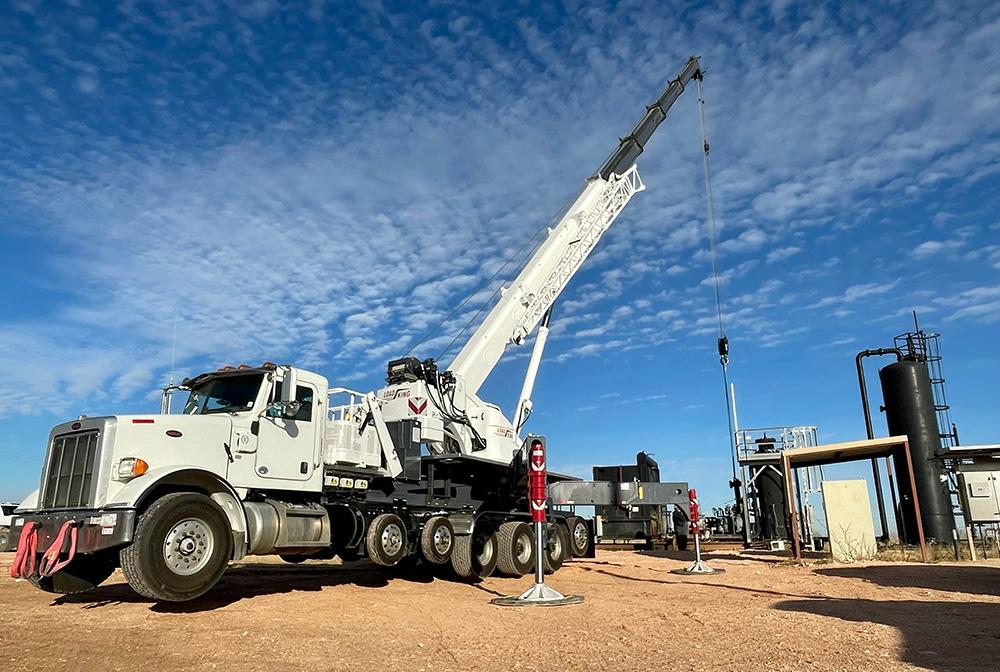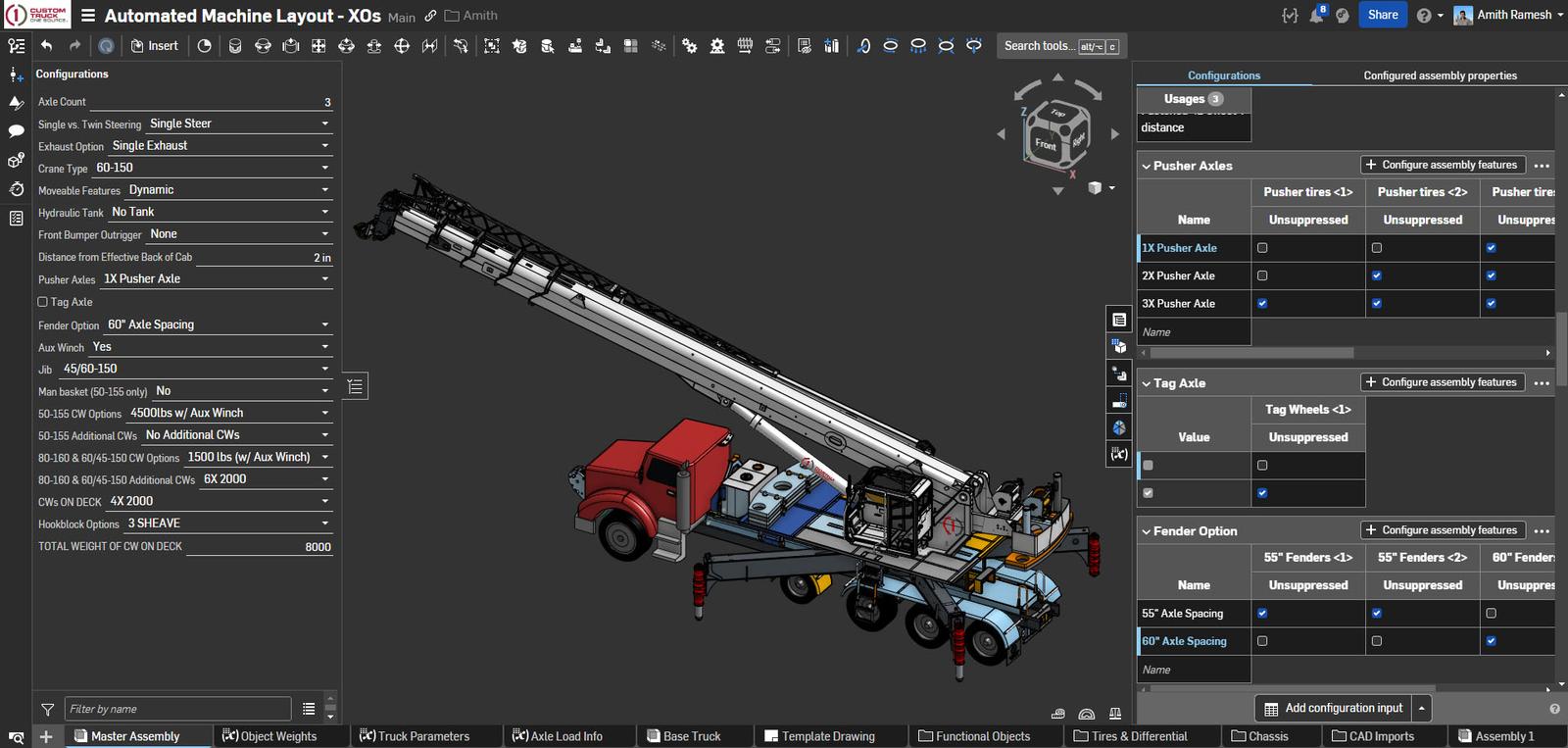The Challenge
With its roots as a certified body builder and assembler, Custom Truck One Source was on a journey towards vertical integration. Its aim: To shore up its engineering muscle so it could design and manufacture many of the key parts and components for its industrial utility truck lines. Its current SOLIDWORKS CAD platform was not up to the task of accommodating a dispersed team of engineers and partners. The limitations of its file-based CAD system and on-going performance issues were hampering Custom Truck’s ability to effectively collaborate on fast-changing designs.
Results
- Onshape’s faster performance is expected to reduce basic CAD operations by at least 15%, bolstering productivity.
- Onshape significantly reduces downtime, which is estimated to save approximately $500,000 in costs.
- Onshape's Branching and Merging feature encouraged independent design exploration and enabled the best ideas to be selectively merged together, advancing design without disruption.
- Custom Truck reduced hardware costs, swapping out expensive workstations for lower level laptops and eliminating server gear.



There are lots of ways Onshape adds value to our company. The performance improvement working in Onshape will allow our engineers to be more efficient and have a better quality of life. Branching and merging helps us iterate design ideas and implement quickly into the production models. The cloud native nature of Onshape makes it easier to work with overseas team members and eliminates the need for expensive servers and heavy IT overhead. The tight integration between CAD and PLM makes workflows more streamlined and reduces our processing time for ECR's and ECO's. In general, Onshape allows us to be a more nimble and creative engineering team.’’

Born as a family-run business, Custom Truck One Source got its start as an upfitter, assembling outsourced industrial equipment onto commercial carriers to create custom-built utility vehicles.
Now a $2 billion-plus multi-divisional business, Custom Truck One Source is taking a turn towards vertical integration, using the cloud-native Onshape CAD & PDM platform to accelerate the design and manufacture of its own critical parts.
Founded in 1996, Custom Truck built up its business buying trucks from OEM giants like Freightliner, Ford, and Peterbilt, and upfitting them with equipment like bucket trucks, digger derricks, water tanks, dump bodies, cranes, service bodies, knuckle booms, and drywall cranes sourced from third-party providers. Custom Truck vehicles are fundamental to supporting this country’s infrastructure—powering the cranes that install well drilling equipment, repair utility lines, or handle downed trees in the aftermath of storms.

The certified body builder business model has been an engine for Custom Truck’s growth over the last decade. Custom Truck began its journey into manufacturing by purchasing Load King, the venerable trailer and low-boy manufacturer in 2015. Then in 2019, with the acquisition of the North American Crane division from Terex, Custom Truck was catapulted fully into designing and manufacturing its own equipment, particularly the aging crossover and truck crane lines which were sorely in need of a design refresh.
“The next phase in our evolution is going from being a purchaser of pieces to a manufacturer and designer of those pieces and bringing that vertical integration in,” says Kyle Gerber, Vice President of Engineering for Custom Truck, which is based in Kansas City, MO. “Our new facility has a section that is dedicated to fabrication and paint. So now we are actually manufacturing the parts that we assemble.”
The new business paradigm positions Custom Truck as a one-stop shop, handling everything from the design of a custom truck all the way through fabrication, aftermarket service, and trade-in for a new piece of equipment at end of life. Customization is another key advantage as customers opt for a standard vehicle and tailor it with a choice of accessory packages based on their specific requirements.
“We literally take it from cradle to grave,” says Chris Beougher, Custom Truck’s Engineering Systems Manager. “We’ve historically made something out of commercially available components and got it ready for customers. Now we’re starting to do that ourselves.”
The limitations of SOLIDWORKS CAD
Custom Truck is a veteran of truck sales, but it is still a relatively young engineering shop. There were significant gaps in its design software toolbox, built around the SOLIDWORKS CAD platform. In addition, its collaboration and development processes didn’t effectively support efficient product design across a global team of internal engineers and outside contract partners.

For example, while it was easy enough to create a part design in SOLIDWORKS, the file-based CAD system makes it much harder to iterate and keep track of design changes, especially when multiple parties are involved. SOLIDWORKS was used in conjunction with the Arena PLM platform, but the combination still required engineers to work in a serial fashion. This created a lot of down time between design changes, which in turn, hampered the development cycle and slowed time-to-market. Moreover, changes made after the hand-off to suppliers caused issues since it was difficult to collaborate on the same design version given the geographically dispersed nature of the team.
“We try to implement changes as quickly as possible, but not being able to start a new change until the last one is fully processed creates significant log jams in our engineering workflow” notes Gerber.
SOLIDWORKS file-based orientation was a drain on productivity for critical steps like searching for files, previewing designs, or even modifying drawings. Oftentimes, engineers were spending upwards of 40 hours on modifying drawings that should only take six to eight hours, Gerber maintains. “When working in one of our large hydraulic installation models, If I have to wait five or ten seconds every time I click my mouse, it’s not a workable solution,” he explains. “It’s a quality of life issue.”
The Onshape advantage
With the success of its new business model on the line, Custom Truck decided to switch lanes, moving away from SOLIDWORKS to the Onshape cloud-native CAD and PDM platform. The cloud offers an easier foundation for Custom Truck’s dispersed team to collaborate, and Onshape’s built-in PDM with CAD allows everyone to work on the same model simultaneously.

Onshape’s git-like branching and merging feature is also critical to Custom Truck. The capability makes it easier for multiple engineers to experiment simultaneously with design options without fear of disrupting each other’s work. Engineers model parts or assemblies in workspaces, essentially their own version of the CAD model known as a branch. As the different design iterations mature, the most viable variations are merged back into the primary design branch without the lag time of check-in and check-out processes typically associated with PDM systems.
“With Onshape you can compare all the design ideas at once, choose the best, and merge them together easily,” Gerber says “This helps us collaborate on design ideas more effectively than before.”
As a cloud-native platform, Onshape promises to rein in a lot of the IT administrative tasks associated with legacy CAD. This will free up engineers to spend less time managing CAD systems and more time on design innovation. Onshape delivers continuous updates every three weeks as opposed to the SOLIDWORKS ecosystem which was haphazard.

ROI in clear sight
Though still in the early stages of the Onshape rollout, Custom Truck is already seeing signs the switch will yield significant ROI. From a productivity standpoint, preliminary design work indicates a 15% reduction, at minimum, in the time it takes to perform critical design tasks. There is also expected savings associated with software performance. The Custom Truck crew experienced multiple crashes a day using SOLIDWORKS; with 70 engineers now part of the extended team, Custom Truck estimates as much as $500,000 was lost annually due to protracted system downtime.
There are expected savings on the hardware front associated with running Onshape in the cloud as well. Instead of allocating $5,000-plus high-end workstations to every engineer, teams can effectively run Onshape on much less expensive laptops. In addition, Custom Truck should be able to eliminate up to four servers, vastly reducing IT infrastructure overhead costs by approximately $17,000 a year.
As Custom Truck shifts Onshape into high gear, it anticipates the new CAD engine will be a major factor in its transformation to vertically-integrated manufacturer. “Historically, we’ve outsourced 99% of what we assemble here,” says Beougher. “Now we’re in the building age, putting our future in our own hands.”





